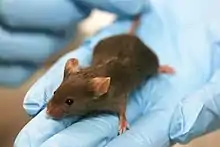Cervical dislocation
Cervical dislocation is a common method of animal euthanasia. It refers to a technique used in physical euthanasia of small animals by applying pressure to the neck and dislocating the spinal column from the skull or brain.[1] The aim is to quickly separate the spinal cord from the brain[2] so as to provide the animal with a fast and painless death;[1] however, research on this method has shown it does not consistently concuss the brain and may not cause instantaneous insensibility.[3]

Technique
Firm pressure is applied at the base of the skull, along with a sharp pinching and twisting of the thumb and forefinger. At the same time, the tail is pulled backward.[4] This severs the spinal cord at the base of the brain or within the cervical spine area (the upper third of the neck).[2] According to the Canadian Council on Animal Care (CCAC), cervical dislocation is normally only conducted on small animals.[1]
Ethics
The University of Iowa and some veterinary associations consider the technique as an ethically accepted method for terminating the life of small rodents such as rats, mice, squirrels, etc.[5]
See also
- Cervical fracture
- Blunt trauma
- Slaughter (livestock)
References
- "Glossary Archived June 29, 2007, at the Wayback Machine." CCAC Programs. 2005. Canadian Council on Animal Care Archived 2009-10-17 at the Wayback Machine. Accessed 13 July 2007.
- Extension "Archived copy". Archived from the original on 2008-01-15. Retrieved 2007-07-13.CS1 maint: archived copy as title (link)
- https://www.hsa.org.uk/neck-dislocation/neck-dislocation
- Hogan, B., F. Constantini, and E. Lacy. 1986. Manipulating the Mouse Embryo: A Laboratory Manual
- University of Iowa. "Euthanasia Archived January 26, 2008, at the Wayback Machine." Accessed 15 August 2007
